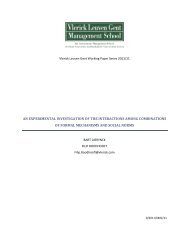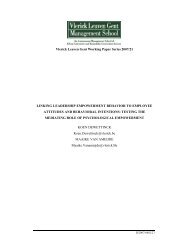innovation and internationalization by indian firms - Vlerick Public
innovation and internationalization by indian firms - Vlerick Public
innovation and internationalization by indian firms - Vlerick Public
Create successful ePaper yourself
Turn your PDF publications into a flip-book with our unique Google optimized e-Paper software.
APPENDIX<br />
Key points for three phases of Innovation in Indian <strong>firms</strong>.<br />
First Phase: 1990s Second Phase: First half of first decade of 2000s Third Phase: Second half of first decade<br />
of 2000s<br />
Overall<br />
Low cost, trade entrepreneurial skill as <strong>innovation</strong>,<br />
to other EMs (e.g., Soviet bloc, Africa, SE e.g., Birla<br />
to Thail<strong>and</strong> <strong>and</strong> Malaysia; Mittal to Kazakhstan <strong>and</strong><br />
Indonesia)<br />
Moving up the <strong>innovation</strong> value chain, primarily<br />
focusing on the Indian market, selective<br />
<strong>internationalization</strong> – both market seeking <strong>and</strong><br />
asset seeking to be better able to compete<br />
domestically<br />
Leveraging business model <strong>innovation</strong><br />
from India to other EMs (china, Africa,<br />
Eastern Europe, Latin America) but also<br />
to some DMs both to leverage existing<br />
<strong>innovation</strong> capabilities but also to<br />
acquire these capabilities<br />
Suzlon in Europe; Dr Reddy’s; Tata’s in<br />
UK<br />
Indian<br />
Context<br />
Expertise from 5 decades of import substitution in<br />
low cost high volume (e.g., generics <strong>and</strong> auto but<br />
also consumer goods); Low cost, mostly using<br />
labour or some other kind of arbitrage;<br />
entrepreneurial skill: lots of small <strong>and</strong> medium size<br />
<strong>firms</strong>, but mostly trade; <strong>innovation</strong> was mostly<br />
about matching supply <strong>and</strong> dem<strong>and</strong><br />
Institutional development; Acceleration of<br />
opening of the Indian economy; macroeconomic<br />
growth; new <strong>firms</strong> entering old <strong>and</strong> new<br />
industries; increased <strong>and</strong> substantial foreign<br />
competition; relaxation on JV investments;<br />
relaxation of capital <strong>and</strong> foreign exchange<br />
controls<br />
Increasing local <strong>and</strong> foreign<br />
competition; experience in competing<br />
with <strong>innovation</strong>; more institutional<br />
evolution, more access to capital;<br />
accelerating macroeconomic growth;<br />
relative improvements in infrastructure<br />
External<br />
Context<br />
Institutional conditions <strong>and</strong> cultural issues, how<br />
governments operated; Industry immaturity: some<br />
market opportunities (e.g., Soviet bloc countries,<br />
Africa) ; similarity in markets (low incomes) <strong>and</strong><br />
supply <strong>and</strong> related infrastructure<br />
Opening up of new markets; institutional<br />
development; access to domestic markets <strong>and</strong><br />
assets <strong>by</strong> foreign <strong>firms</strong><br />
Liberalization in many markets;<br />
Economic crisis; Protectionism in some<br />
markets; Institutional evolution,<br />
Industry immaturity <strong>and</strong> evolution<br />
18










